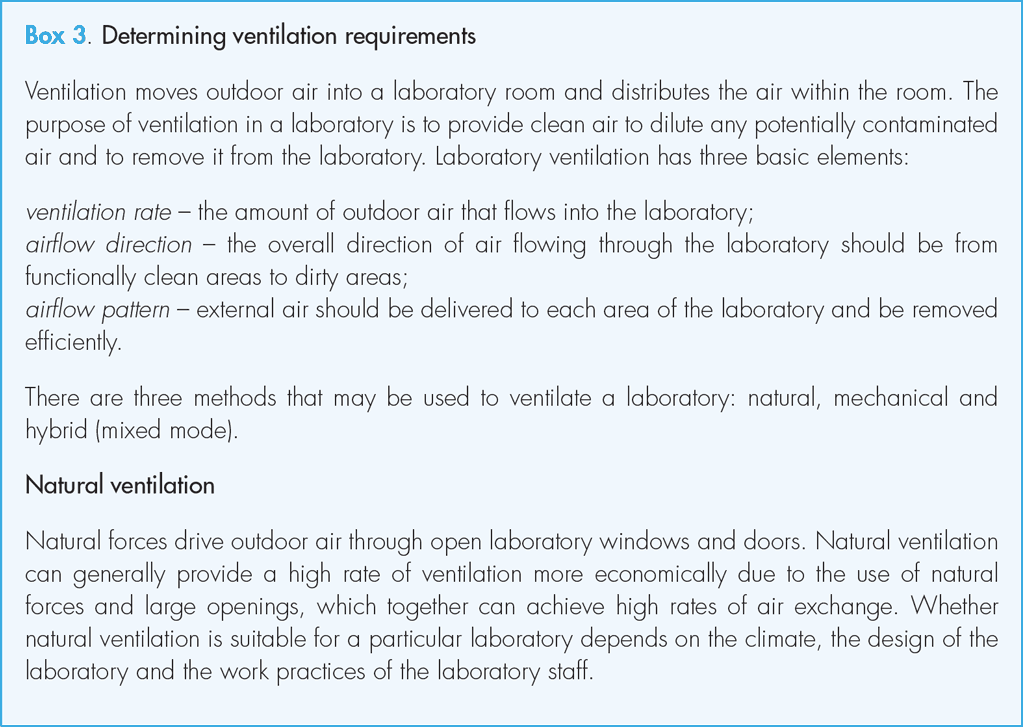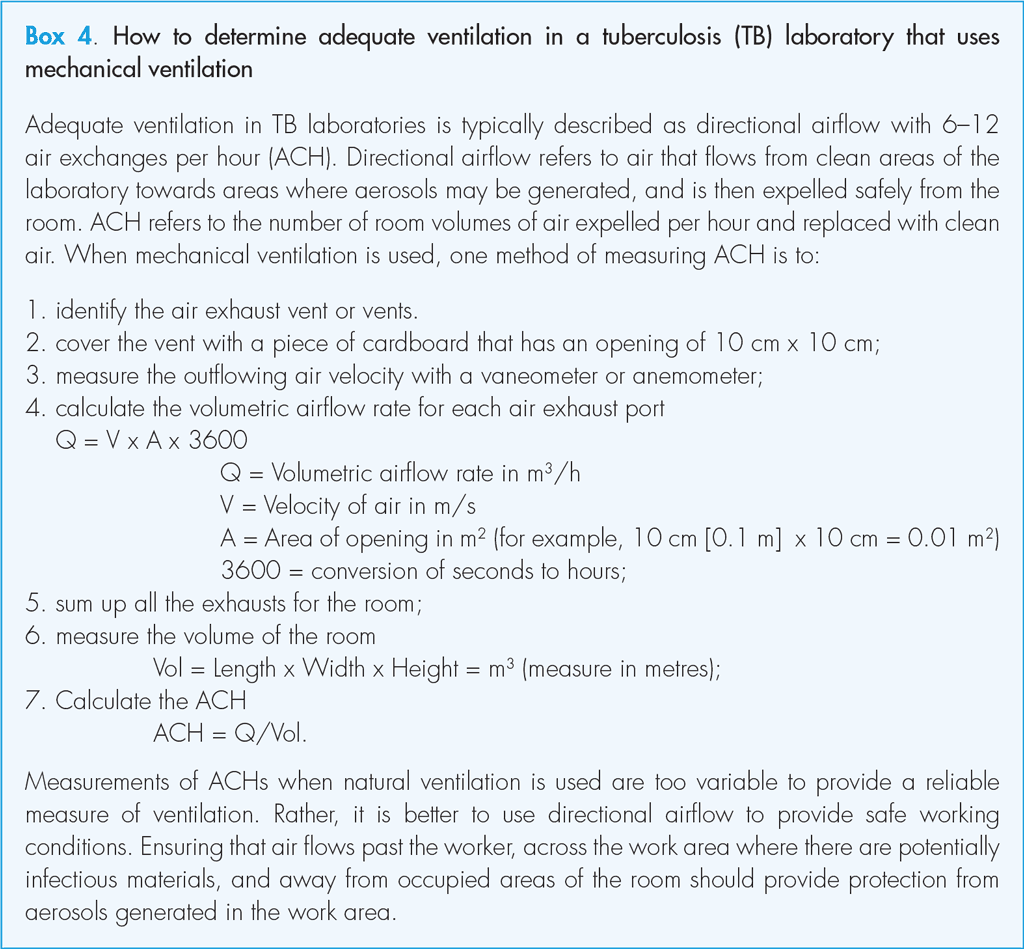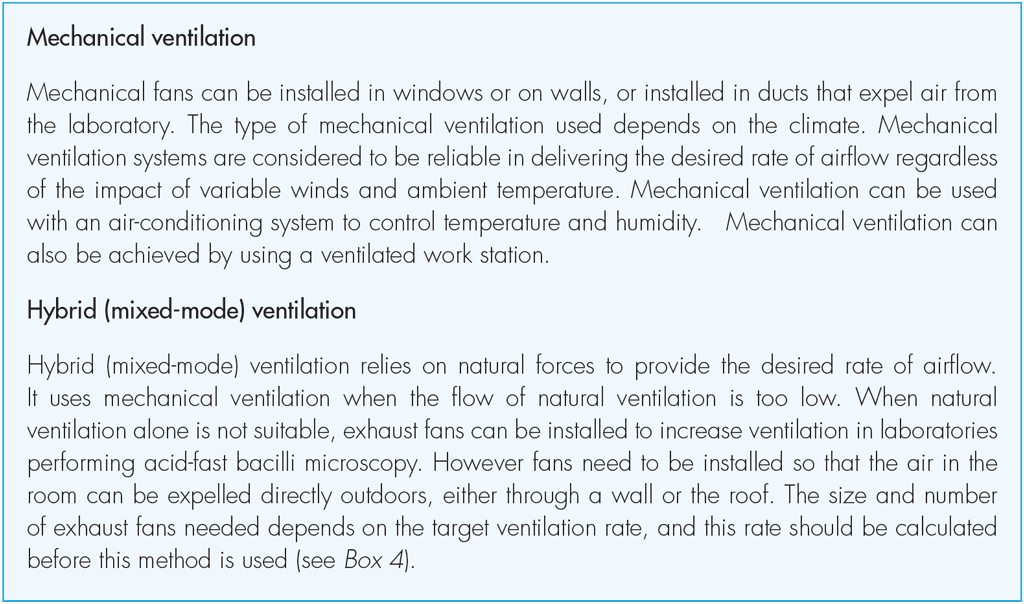Book traversal links for 3.2 Specific features and essential minimum biosafety measures
To address specific potential risks, the following biosafety requirements¹⁴ ¹⁵ should be established in a low-risk TB laboratory.
1. Use of bench spaces: The bench used to process specimens for direct sputum-smear microscopy or the Xpert MTB/RIF assay should be separate from areas used to receive specimens and from administrative areas used for paperwork and telephones.
2. Ventilation: Smears performed directly on sputum samples, and processing specimens for the Xpert MTB/RIF assay, may both be carried out on an open bench in an adequately ventilated area when appropriate microbiological techniques are used.
Adequate ventilation for TB laboratories is typically described as directional airflow with 6–12 air exchanges per hour (ACH) (see Boxes 3 and 4). Directional airflow refers to air flowing from clean areas towards areas where aerosols maybe generated; this air should be safely discharged from the room. “Air exchanges per hour” refers to the number of room volumes of air expelled per hour and replaced with clean air. When mechanical ventilation is used, air exchanges per hour can be readily calculated.
For low-risk procedures, natural ventilation should be sufficient providing that air flows away from the technician and across the work area along with potentially infectious materials, then away from occupied areas of the room and outside the laboratory; this fl ow should provide protection from aerosols that might be generated in the work area. In order to have directional control of contaminants in the air, air should move at least 0.5 m/s.¹⁶
Ventilation can be ensured by opening windows if the local climate allows. When the climate prevents windows from being opened, consideration should be given to using mechanical ventilation systems that provide an inward flow of air without recirculation in the room. Air conditioners should be placed only after the direction of airflow has been considered. It is important to ensure that air in the laboratory flows away from the technicians.
Ventilated work stations are an optional solution for aerosol containment for direct sputum-smear microscopy or the Xpert MTB/RIF assay in environments where natural or mechanical ventilation is not practical. Guidance and specifications for ventilated work stations are available.¹⁷


3. Minimizing the generation of aerosols:
Preparing sputum samples for direct sputum-smear microscopy or for the Xpert MTB/ RIF assay theoretically has the potential to generate aerosols. However, because sputum specimens are usually viscous, aerosol generation can be minimized by using good microbiological techniques. Care should be taken when opening specimen containers, which may have been shaken during transportation to the laboratory. The risk of infectious material spattering in an open Bunsen burner flame should be avoided when drying smears. It is preferable to air-dry smears, and use a flame to fi x the smears only when they are completely dry. Disposable wooden applicator sticks or transfer loops are preferred for making smears.
4. Handling leaking specimen containers:
The integrity of specimen containers delivered to the laboratory needs to be checked upon arrival to the laboratory. Leaking containers may need to be discarded and a fresh sample requested. If an adequate specimen remains in a leaking container, the container may be decontaminated with a suitable disinfectant before processing. Samples should be transported to the laboratory in an upright position to minimize leakage.
5. Personal protective equipment: Each country and facility must evaluate its risks and decide on the level of personal protection that is appropriate for the different procedures being undertaken. Protective laboratory coats should be worn at all times in the laboratory. Gloves must be worn for all procedures that involve direct contact, or may involve accidental contact, with sputum, blood, body fluids and other potentially infectious material. Gloves must be changed regularly and should not be reused. Staff should always wash their hands before leaving the laboratory.
Respirators are not required for use during the preparation of sputum smears.

 Feedback
Feedback